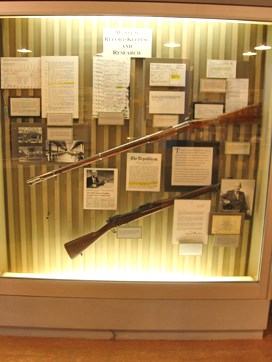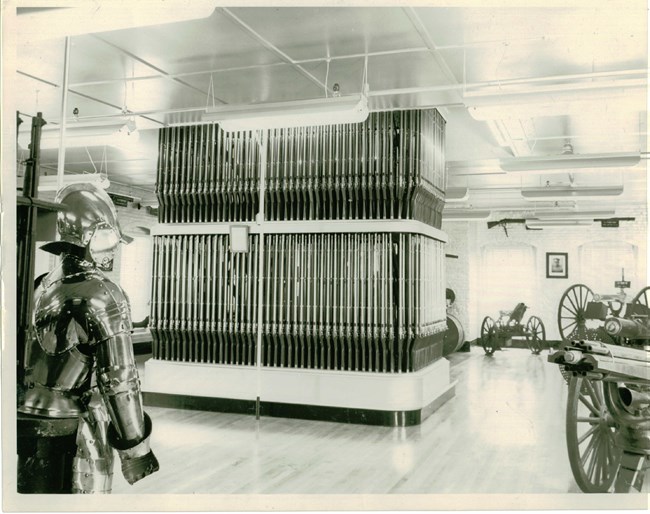
Springfield Armory NHS, US NPS Springfield Armory was established during the administration of George Washington as a manufactory of military arms. Its museum function developed largely by accident. During and after the Civil War, large number of captured and surplus weapons were sent to the Armory to be reconditioned. Many of these were deemed to have no military value and were put aside as curiosities. This was the beginning of the museum collection. ********** 
Springfield Armory NHS, US NPS At the outset of the Civil War, when the Union was forced to buy arms from any available source, European arsenals were scoured for surplus weapons. So many kinds of weapons arrived that the Armory commander was ordered to keep a sample of each. These guns were collectively called "Bokers" after the company that was the primary importer. Later, these specimens were added to the collection.
********** 
Springfield Armory NHS, US NPS
A .72 cal. musket from Suhl, Germany, is typical of the "Bokers" - outdated arms that European governments were happy to unload in this country. ********** 
Springfield Armory NHS, US NPS 
Springfield Armory NHS, US NPS Benton Collection bronze plaque The museum can no longer depend on weapons picked up on distant battlefields to augment its collection. Like most museums, we depend on donations for continued growth. Despite its size, the collection still has several voids we would like to fill. (A current list of our most urgent "wants" is kept at the Information Desk.) In addition to firearms, we welcome donations of tools, documentation, and similar memorabilia related to the Armory. Under the guidelines of our "Scope of Collections," emphasis is given to Springfield Armory products, other military small arms, and material pertaining to the history of the Armory. ********** 
Springfield Armory NHS, US NPS Brought here during World War II, this captured German FG 42 "paratrooper rifle" was carefully studied and influenced the design of later weapons. ********** 
Springfield Armory NHS, US NPS Environmental Monitoring Monitoring the museum environment is essential to the health of a museum, its objects and its visitors. The museum environment is composed of the relative humidity and the temperature. If the temperature becomes too cold, the relative humidity could rise, and eventually condense water vapor on the metal, causing rust. Conversely, if the temperature becomes too warm, the relative humidity could drop, causing severe drying of the wood. With the Museum apparently becoming a permanent fixture, efforts began to manage it in accord with established museum practices. The 1909 catalog represents an early attempt to get the collection under systematic control. ********** 
Springfield Armory NHS archives cat.#6530-sa.a.1, US NPS Another cataloging effort by the Armory began in the 1930’s. Like the earlier attempt, it was not completed. Today the National Park Service uses a specialized computer program to manage the collection. Detailed information on each weapon is readily available to the museum’s curators and other researchers. Computers and database technology added still better tools for both curators and researchers to sort and combine objects with similar backgrounds. Today, the National Park Service is testing a new database technology which joins imaging with text block information fields to display complete information about an object for the museum visitor. ********** 
Springfield Armory NHS collection SPAR 2439, US NPS A PERSONALLY-MARKED CIVIL WAR ENFIELD RIFLE MUSKET A decorated Civil War Enfield inscribed "Mattie Be True" by a sentimental soldier caught the attention of inspectors and was set aside. It has remained in the collection ever since. **********

Springfield Armory NHS collection, cat.#: SPAR 1500, US NPS US M1903 rifle, serial number 1 Retaining and displaying especially significant guns, such as the M1903 Serial Number 1, helped secure public interest and support for the Armory.
********** 
Springfield Armory NHS, US NPS After the decision to close Springfield Armory in 1964, many citizens of Springfield, aided by supporters elsewhere in the nation, sought to retain the museum in the city. Eventually the Department of the Army agreed, and this building was transferred to the city, while the collection was loaned to a semi-private organization, Springfield Armory Museum, Inc. Springfield Armory National Historic Site was established by Congress in 1974 and in 1978 the National Park Service assumed management of the museum. Since then much effort has gone into renovating and improving the resources entrusted to the care of the National Park Service. |
Last updated: June 16, 2021

